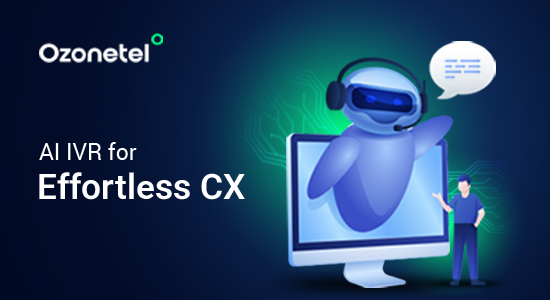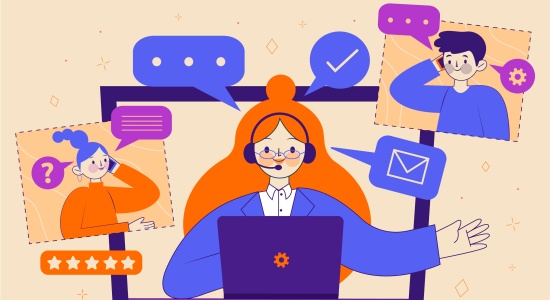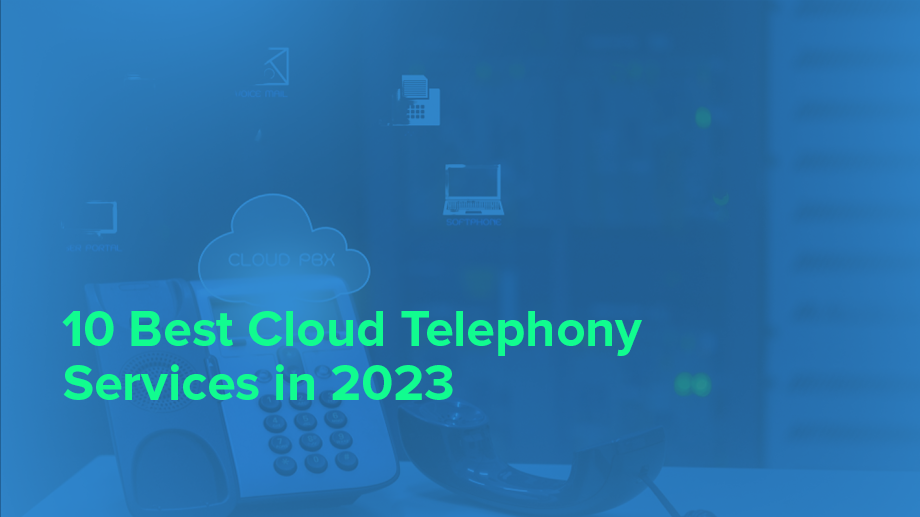- Resources
- The Ultimate Guide to Building a Customer-Centric Business
The Ultimate Guide to Building a Customer-Centric Business

A customer-centric business isn’t just about good service—it’s about making customers the driving force behind every decision. From the way you design products to how you handle support, every aspect of your business should focus on solving real customer problems and delivering value.
When you put customers first, you don’t just improve satisfaction—you build loyalty, increase retention, and create a business that grows through trust and strong relationships. In this guide, we’ll break down what customer centricity really means and how you can make it a core part of your strategy.
In this article, we will explore:
What Is Customer Obsession?
Customer obsession is about placing your customers at the core of every decision you make. It goes beyond simply satisfying their needs—it’s about actively working to improve their experience at every touchpoint, anticipating what they want, and addressing their concerns before they even raise them.
What is Customer Centric Business?
A customer-centric business prioritizes customer needs at every stage, from product development to service delivery. It focuses on understanding customer expectations, perceptions, and challenges to create better experiences. Every decision—from pricing to marketing—is made with the customer in mind, leading to higher satisfaction, loyalty, and advocacy.
Why Customer-Centricity Matters
Putting customers at the core of your business isn’t just a strategy—it directly impacts revenue, loyalty, and long-term success. Companies that focus on customer needs outperform competitors in multiple ways. Here’s how:
Higher Revenue and Profitability
Customer-centric businesses grow 4% to 8% faster than competitors because they focus on building long-term relationships rather than just driving short-term sales. Happy customers stay longer, spend more, and are more likely to recommend a brand to others.
Since acquiring a new customer costs five times more than retaining one, businesses that invest in customer satisfaction see stronger financial returns. Prioritizing customer experience isn’t just about service—it’s a smart business strategy that reduces churn and increases lifetime value.
Stronger Customer Trust and Loyalty
Customers today expect more than just good products—they want meaningful interactions. A positive service experience accounts for nearly two-thirds of customer loyalty, surpassing brand perception and pricing.
Companies that invest in personalized support and proactive engagement build stronger relationships, leading to a 25% increase in customer loyalty and a 20% boost in confidence. When customers feel valued, they are more likely to return, recommend your brand, and stay engaged long-term.
Personalized Experiences Drive Growth
A generic approach no longer works—customers expect businesses to understand their preferences and tailor experiences accordingly. Companies that personalize interactions see 40% more revenue than competitors that don’t.
However, failing to meet these expectations leads to frustration—76% of customers report being dissatisfied when they don’t receive personalized service. By leveraging customer insights and offering tailored recommendations, businesses can improve engagement, increase sales, and foster deeper connections with their audience.
Competitive Advantage in the Market
Customer experience has a direct impact on business performance. Research shows that companies leading in customer experience saw their stock prices outperform competitors by 66% points.
Businesses that ignore customer expectations risk falling behind, while those that actively listen and respond to customer needs gain a competitive edge. A customer-first approach isn’t just about retention—it’s about staying ahead of industry trends and continuously improving based on real customer feedback.
Long-Term Customer Value
Loyal customers contribute more to a business’s success than one-time buyers. When customers feel heard and valued, they are more likely to return, increasing their lifetime value.
Since repeat customers are easier and more cost-effective to maintain, investing in better customer experiences leads to higher profits over time. Retention efforts—whether through personalized communication, proactive support, or loyalty programs—create a stable revenue stream, helping businesses scale sustainably.
Challenges to Overcome When Becoming a Customer-Centric Company
Shifting to a customer-centric approach is not just about good intentions—it requires a realignment of priorities, resources, and execution strategies. Many companies struggle to make this shift effectively, often falling into common traps that derail their progress.
Here are the key challenges you need to navigate.
Execution Failures
Some companies plan well and allocate funds properly but still fail to execute. Operational inefficiencies, lack of collaboration, and miscommunication can slow progress or block it altogether.
For example, a health insurance company launched a customer-centricity initiative with hospitals but struggled with execution. Operations teams from both sides blamed each other, and the project stalled for 18 months. The issue was resolved only when leadership stepped in, clarified roles, and improved communication channels.
Lack of Resource Alignment
Even with the right strategy and customer understanding, companies often fail to allocate the necessary resources—whether it’s funding, staff, or training. This leads to great ideas that never materialize.
For example, a global internet services provider had strong customer-aligned ambitions but failed to allocate resources effectively. Team members weren’t given the time or training needed to execute projects. The company started missing critical market trends. To fix this, they introduced customer advisory boards to allocate resources where needed, ensuring execution didn’t stall.
Internal Focus Over Customer Needs
Some companies focus too much on internal processes rather than aligning with customer priorities. They mistake internal efficiencies for customer-centric improvements, leading to misalignment and lost opportunities.
For example, a tier-one automotive supplier intensified its internal cost-cutting measures instead of collaborating with customers to find mutual efficiencies, losing major contracts. The company recovered by benchmarking top-customer relationships and working with clients to identify cost-saving opportunities.
How to Build a Customer-Centric Business Strategy
Being customer-centric isn’t just about good service—it’s about structuring your entire business around your customers’ needs. This means shifting from an internal, product-first mindset to an approach where customer experience drives decisions at every level. Here’s how you can build a customer-centric strategy that delivers real value.
1. Define What Customer-Centricity Means for Your Business
Before you build a strategy, you need to clarify what being customer-centric actually means for your business. A retail brand will define it differently than a SaaS company. Start by answering:
- Who are your core customers? (Demographics, behaviors, pain points)
- What specific problems are they trying to solve?
- What does an ideal experience look like for them?
Avoid vague goals like “delight the customer.” Instead, define measurable objectives—such as reducing customer effort, improving response time, or increasing repeat purchases. When your team understands what customer-centricity means in concrete terms, they can work toward it more effectively.
2. Shift from Product-First to Customer-First Thinking
Many businesses focus too much on their product or service and not enough on how customers interact with it. You need to shift the focus from “How do we sell this?” to “How do customers use this?”
Ask yourself:
- Where do customers experience friction? (e.g., difficult onboarding, lack of support, confusing pricing)
- Are you making decisions based on internal assumptions or real customer feedback?
- Do you optimize for what’s easiest for your company or what’s best for the customer?
For example, if customers frequently abandon sign-ups due to a complicated process, simplify it instead of assuming they’ll figure it out. If support tickets show recurring issues, fix the root cause instead of just improving response time.
3. Collect Meaningful Customer Insights (Beyond Surveys)
Surveys provide surface-level insights, but they don’t always reveal deeper motivations. You need multiple feedback sources to understand customers truly:
- Customer interviews – Ask open-ended questions to uncover frustrations and unmet needs.
- Support ticket analysis – Identify patterns in recurring problems.
- Behavioral data – Track how customers interact with your website, app, or product to pinpoint friction points.
- Social listening – Monitor conversations on forums, reviews, and social media for unfiltered feedback.
Look for patterns, not just individual complaints. If customers are struggling with the same issue, it’s a business problem—not just a user error.
4. Build Cross-Functional Accountability for Customer Experience
A customer-centric business requires every department to take responsibility for customer experience—not just support teams. If product, sales, and marketing aren’t aligned, customers will experience inconsistencies and frustration.
Steps to implement cross-functional accountability:
- Set shared KPIs that focus on customer outcomes (e.g., reducing churn, improving NPS, increasing retention).
- Make customer feedback visible to all teams, not just support and marketing.
- Encourage direct customer interactions across departments. Product teams should participate in support calls, sales should analyze churn reasons, and marketing should test messaging with real users.
When teams work in silos, customer pain points get lost. Making customer experience a company-wide responsibility ensures consistency.
5. Personalize Without Overcomplicating
Customers expect personalization, but overly complicated efforts can feel forced or intrusive. Instead of hyper-personalizing everything, focus on smart segmentation and effortless interactions.
- Group customers by behavior and needs (not just demographics). A returning customer may need different messaging than a first-time buyer.
- Streamline onboarding so customers can quickly get value from your product or service.
- Make recommendations based on past behavior rather than asking them to re-enter preferences repeatedly.
The key is to reduce friction while making interactions more relevant—not to overwhelm customers with excessive customization.
6. Prioritize Long-Term Relationships Over One-Time Transactions
Many businesses focus too much on acquiring new customers while neglecting existing ones. A customer-centric strategy prioritizes lifetime value over short-term sales.
Ways to build long-term relationships:
- Proactively solve customer problems before they escalate.
- Develop loyalty programs that actually reward retention, not just sign-ups.
- Provide post-purchase support that makes customers feel valued beyond the initial sale.
If customers only hear from you when you want to sell something, they won’t feel valued. Show them that you care beyond the transaction.
7. Build Flexibility into Your Policies and Processes
Rigid policies that prioritize internal efficiency over customer satisfaction create frustration. Instead of enforcing one-size-fits-all rules, give employees the flexibility to make judgment calls when necessary.
How to introduce flexibility:
- Empower frontline employees to solve issues without requiring multiple approvals.
- Offer resolution options instead of forcing customers to use single refund or exchange policy.
- Streamline internal processes so customers don’t have to jump through unnecessary hoops.
For example, if a long-time customer requests a refund slightly past the deadline, allowing flexibility builds goodwill instead of losing them permanently.
8. Close the Loop on Customer Feedback
Many businesses collect feedback but fail to act on it—or if they do, they don’t communicate changes back to customers. This weakens trust.
Here’s how to close the loop effectively:
- Acknowledge feedback publicly (e.g., in emails, product updates, or social media).
- Follow up with customers personally if they reported an issue and a fix has been made.
- Measure the impact of changes—if a new policy was introduced based on feedback, track if it actually improved customer experience.
Customers want to know their input matters. If they see changes based on their suggestions, they’re more likely to stay engaged.
9. Train Employees to Think Like Customers
A customer-centric culture requires employees to see issues from the customer’s perspective, even if they don’t work in a customer-facing role.
Ways to train employees:
- Include customer experience training in onboarding.
- Have employees shadow customer support to understand real frustrations.
- Encourage teams to identify and fix friction points in their workflows that affect customers.
When employees experience firsthand what customers go through, they naturally start making decisions that prioritize the customer.
10. Measure What Actually Matters to Customers
Many businesses focus on internal metrics like response time or resolution rates—but these don’t always reflect real customer satisfaction. Instead, track:
- Customer effort score (CES) – Measures how easy it is to interact with your business.
- Churn reasons – Understand why customers leave and fix recurring issues.
- Customer lifetime value (CLV) – Measures the total revenue a customer brings over time.
- Time to resolution – Tracks how quickly and effectively issues are resolved.
Focusing on the right metrics ensures that you improve what matters to the customer, not just what is convenient for your business.
Examples of customer-centric businesses
Customer-centric businesses prioritize efficiency, personalization, and seamless experiences across every interaction. Here are a few companies leveraging AI-driven solutions to enhance customer engagement:
Treebo Hotels
Treebo Hotels recognized that long wait times for booking-related queries—such as room availability, pricing, and modifications—were affecting customer satisfaction. By implementing Ozonetel’s self-service IVR, they automated 60% of routine inquiries, allowing customers to get quick answers without waiting for an agent.
This not only improved response times but also enabled agents to focus on personalized assistance for more complex concerns, enhancing the overall booking experience.
Wakefit
Wakefit faced customer frustration due to delays in query resolution, as many cases required follow-ups and callbacks. By integrating Ozonetel CCaaS with their ticketing system, they empowered frontline agents with direct access to critical information, significantly reducing dependency on other teams.
This led to a 75% increase in First Call Resolution (FCR) and a 25% drop in call volumes, ensuring that customers received quick and efficient resolutions without repeated follow-ups. By eliminating unnecessary escalations, Wakefit provided a smoother support experience, reinforcing trust and loyalty.
Muthoot Gold
Muthoot Gold identified that timely installment payments were crucial for customers who had purchased gold on a loan. Instead of relying on manual reminders from agents, they introduced an AI-powered voice bot to handle these communications.
This shift resulted in a 5-8% increase in on-time payments and ensured customers received consistent, non-intrusive reminders. By automating repetitive tasks, Muthoot optimized workforce utilization while maintaining a customer-friendly approach to financial reminders.
IKEA
IKEA’s approach to customer centricity goes beyond just selling furniture—it’s about creating an effortless and engaging shopping experience. The brand understands that customers want both inspiration and convenience. Its immersive in-store setup, complete with curated showrooms, food courts, and childcare services, ensures a stress-free visit.
On the digital front, the IKEA Place app helps customers visualize furniture in their own space using augmented reality (AR), making online shopping more intuitive and personalized. By eliminating uncertainty and friction in the buying process, IKEA ensures customers feel confident in their purchases, reinforcing loyalty and satisfaction.
L’Oréal
L’Oréal understands that beauty is deeply personal, and a one-size-fits-all approach doesn’t work. To cater to individual needs, the brand launched L’Oréal Perso, an AI-powered smart device that customizes skincare, foundation, and lipstick based on real-time skin analysis.
By considering environmental factors like pollution and UV exposure, Person creates hyper-personalized formulations, giving customers greater control over their beauty routines. This direct involvement in the customization process builds trust and deeper engagement, reinforcing L’Oréal’s commitment to customer-centric innovation.
Hilton
With millions of guests staying at Hilton properties every year, ensuring personalized, frictionless experiences is key. The Hilton Honors app enables guests to book stays, choose rooms, check-in, unlock doors, and even order meals—all from their smartphones.
By leveraging digital convenience, Hilton minimizes hassle, allowing staff to focus on delivering meaningful, in-person interactions. This seamless blend of technology and human touch ensures that every guest, regardless of their location, feels valued and in control of their stay, making Hilton a leader in customer-centric hospitality.
Wayfair
With millions of products available, Wayfair ensures customers don’t feel overwhelmed by using AI and predictive analytics to curate personalized recommendations. Instead of generic product listings, Wayfair’s machine learning technology suggests complementary items, helping customers find what they need without endless scrolling.
By analyzing 40 billion customer interactions annually, Wayfair ensures that every shopper receives a tailored experience, making furniture shopping faster, easier, and more enjoyable.
McDonald’s
McDonald’s goes beyond traditional marketing by using social listening to understand cultural trends and customer interests. Instead of broad, generic campaigns, the brand leans into subcultures, like anime fandoms, as seen in the WcDonald’s campaign, which paid homage to its references in anime over the years.
By acknowledging niche communities and integrating customer-driven insights into its branding, McDonald’s strengthens emotional connections with its audience, ensuring that fans feel heard, understood, and valued.
How to Measure the Impact of Your Customer Centricity
Measuring customer centricity helps you understand how well your strategies align with customer expectations and contribute to business growth. Here’s how you can assess the effectiveness of your customer-centric approach using key metrics and financial indicators.
1. Customer Satisfaction (CSAT)
Customer Satisfaction Score (CSAT) is a direct measure of customer happiness. You can collect CSAT data through post-interaction or post-purchase surveys, asking customers to rate their satisfaction on a scale (e.g., 1-5 or 1-10).
Formula:
CSAT (%) = (Number of satisfied customers / Total number of respondents) × 100
Why It Matters:
- Helps you pinpoint areas that need improvement.
- Identifies trends in customer sentiment over time.
- Provides insights into the effectiveness of new initiatives.
A high CSAT score indicates that customers are generally happy with your product or service, while a low score signals areas needing attention.
2. Net Promoter Score (NPS)
NPS measures customer loyalty by asking:
“How likely are you to recommend [business name] to a friend or colleague on a scale of 0-10?”
Responses fall into three categories:
- Promoters (9-10): Loyal customers who actively recommend your brand.
- Passives (7-8): Neutral customers who are satisfied but not enthusiastic.
- Detractors (0-6): Unhappy customers who may discourage others from using your brand.
Formula:
NPS = % of Promoters – % of Detractors
Why It Matters:
- Indicates customer advocacy and word-of-mouth potential.
- Helps you identify areas where customer experience can be improved.
- It can be benchmarked against competitors for industry insights.
A positive NPS suggests strong customer loyalty, while a negative NPS highlights the need for experience improvements.
3. Customer Effort Score (CES)
CES evaluates the ease with which customers can complete tasks such as making a purchase or resolving a support issue.
How to Measure:
- After key interactions, ask: “How easy was it to complete your task?”
- Responses are typically collected using a 1-10 scale, Likert scale, or emoji-based survey.
Why It Matters:
- A lower effort score indicates a smoother customer journey.
- High effort levels often correlate with customer churn.
- Helps refine processes to improve user experience.
For example,reducing friction in your helpdesk system could improve customer retention if customers find it difficult to resolve issues with supporn.
4. Customer Lifetime Value (CLV)
CLV measures the total revenue a business can expect from a single customer over their entire relationship with the brand.
Formula:
CLV = Average purchase value × Average purchase frequency × Average customer lifespan
Why It Matters:
- Helps prioritize high-value customer segments.
- Guides decisions on customer retention strategies.
- Shows whether your customer-centric initiatives lead to long-term profitability.
A rising CLV indicates strong brand loyalty and repeat purchases, while a declining CLV signals retention issues.
5. Customer Churn Rate
The churn rate tracks the percentage of customers who stop doing business with you over a given period.
Formula:
Churn Rate (%) = (Number of customers lost during the period / Total customers at the start of period) × 100
Why It Matters:
- High churn means customers are dissatisfied.
- Helps determine the effectiveness of customer retention strategies.
- This can be reduced by improving service, engagement, and personalization.
Tracking churn alongside CLV gives a clearer picture of customer satisfaction and business health.
Conclusion
A customer-centric business thrives on delivering seamless, personalized experiences across every touchpoint. This is where AI-driven solutions like Ozonetel’s oneCXi come in—helping enterprises engage, convert, and retain customers with precision.
With AI-engineered tools such as CXi Agents, businesses can automate workflows, analyze conversations in real time, and integrate effortlessly with existing platforms. This streamlines operations and makes sure that every customer interaction is meaningful and value-driven.
As brands increasingly prioritize customer-centricity, using AI-driven platforms like oneCXi becomes important to deliver cohesive experiences, understand customer needs, and maximize lifetime value.
Want to see what Ozonetel can do for your company? Sign up today for a free 7-day trial.
Frequently Asked Questions
The 10 types of customers include:
- Potential Customers
- New Customers
- Confused Buyers
- Loyal Customers
- Angry Customers
- Lapsed Customers
- Need-based Customers
- Referring Customers
- Discount-Seeking Customers
- Curious Customers
The four primary types of customers are:
- New Customers – those trying your product or service for the first time.
- Returning Customers – familiar with your brand and come back for more.
- Loyal Customers – repeat buyers who trust your brand.
- Discount Customers – attracted mainly by deals or offers.
A customer is an individual or entity that purchases goods or services from a business. Customers are essential to a business’s success, as their needs and satisfaction drive growth and sales.







